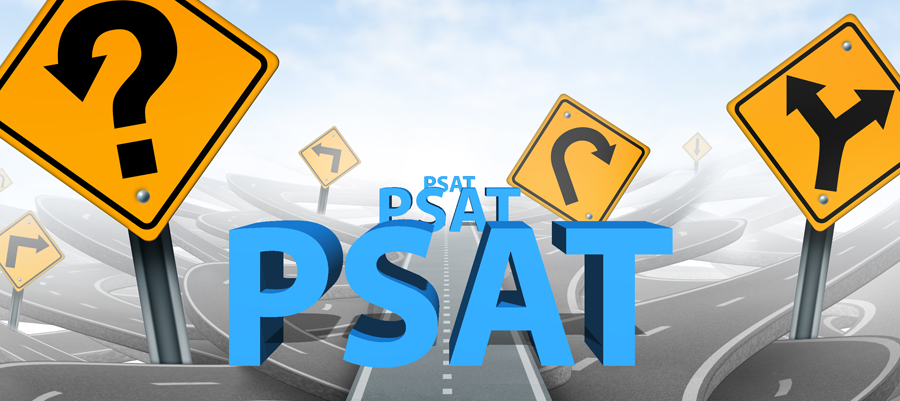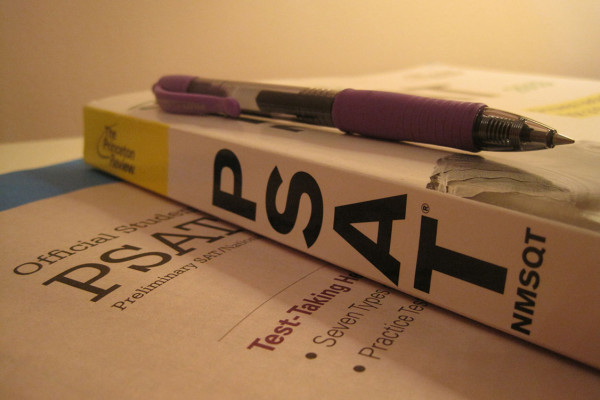There are three types of PSAT (Preliminary Scholastic Assessment Test) tests held by the College Board –– an institution that assesses your readiness for college. The College Board also helps students to succeed on their academic path. Two of the PSATs have their own highest scores. If you take PSAT 8/9, the highest total number of points you can get is 1,440, while the PSAT10’s or PSAT/NMSQT’s maximum scores are equal to 1,520. Let’s find out more details about each of the tests.
What Are the PSAT Sections and Scores?
Sections
The total score of the PSAT8/9 is equal to 240-1,440, and it comprises two section scores. The sections are called Evidence-Based Reading and Writing (EBRW) and Math. And each of them has the highest score of 720. There are three test-scores: Math, Writing and Language, and Reading, and each of them can bring you 6-36 marks. Two cross-tests that check your analytical skills in History/Social and Science include questions from the EBRW and Math sections. These two tests can score 6-36. And finally, six subscores that bring 1-15 points (each). They test:
- Words in Context and Command of Evidence (from Reading, Writing, and Language);
- Standard English Conventions and Expression of Ideas (from Writing and Language);
- Problem-Solving and Data Analysis and Heart of Algebra (from Math).
Though the structures of the PSAT10 and PSAT/MNSQT tests are similar to the PSAT8/9, the scores are slightly greater:
- Total score is 320-1,520;
- Section scores are 160-760;
- Test and cross-test scores can bring 8-38 points;
- Subscores (here are 7 of them) earn you the same 1-15 points.
How Many Questions Will I Answer?
The PSAT8/9 test consists of 38 questions in the Math section, 40 questions related to the Writing section, and 42 questions from the Reading section. You will have 2 hours, 25 minutes to answer all 120 questions. Students are allowed to have two short breaks (usually five minutes each).
The PSAT10 and PSAT/NMSQT have 139 questions in total that split across the sections. The test includes 48 questions from the Math section, 44 –– from the Writing section, and 47 –– from the Reading section. You will be given 2 hours, 45 minutes to attempt your test, plus two five-minute breaks.
The Math section of the PSAT10 and PSAT/NMSQT tests is split into the calculator-allowed questions (31), and the remaining questions (17) must be attempted without a calculator.
What Are the Differences Between the Three Types of PSAT tests?
There are three types of PSAT tests held by the College Board. They are:
- PSAT 8/9 –– for the students of the 8th and 9th grade
- PSAT10 –– for those who study in the 10th grade
- PSAT/NMSQT –– for 10th and 11th-graders.
All three tests are held at your school, and often your school covers the administrative fee of $17. Apart from the scores, structure, and timing differences between the PSAT8/9 and the two other PSATs described above, they differ in purpose too. Taking the PSAT 8/9 is the first step towards your preparation process for entering college. The PSAT10 is identical in structure and content to the PSAT/NMSQT, and this is the second step for you to get ready for the final SAT.
The NMSQT abbreviation stands for the National Merit Scholarship Qualifying Test. Apart from its purpose to evaluate your skills and knowledge, this is the only kind of test that makes you eligible for the scholarship.
US students can apply for one of the four scholarships available:
- College-sponsored Merit Scholarships
- Corporate-sponsored Special Scholarships
- Corporate-sponsored Merit Scholarships
- National Merit $2500 Scholarships.
Scholarship Opportunity
Requirements for each scholarship type can change from year to year. The qualification procedure and list of requirements for each of the four scholarships also differ. However, you need to get the 99th percentile in scores, which means you will have to demonstrate exceptional academic knowledge.
Please note that PSAT/NMSQT is technically available for both 10th and 11th-grade schoolers, but only junior-year ones can apply for scholarships. If you got 1,440-1,520 points of 1,520 in your PSAT/NMSQT being still a sophomore, this would only be an outstanding result. And if you want to apply for a scholarship, you will have to attempt the NMSQT next year and get the same high score. However, you may opt for the Academic Recognition program.

What Do All These Numbers Mean?
Score Ranges: Can Your Score Change?
Score Ranges consider that your PSAT performance can slightly vary depending on some administrative or other factors, provided that your skill remains unchanged. The College Board allows a 20-30 score range assuming that your result will slightly vary each time you take it. For example, several times a week or a month.
Benchmarks: Are You Ready for College?
When you see your PSAT results, there are two benchmark scores for each section. This is the number that the College Board evaluates. And it represents the level of good academic readiness, so you could study well in college. If your score is equal to or greater than the benchmark, this means you are on track to college.
You will also understand it from the color your score is on. If you are on the green line, keep studying with the same effort. If your mark is on the yellow line, the College Board thinks you are approximately one year behind the preparation plan. Once your score hits the red line, don’t panic as you still have time to prepare for your SAT. Your online report will show you the areas that need to be improved.
Mean (Average) Scores
The average score is calculated as the total scores of all US PSAT-takers divided by these students’ number. If your score is around the average number, you are developing the skills you will need in college. But do not try to compare your performance to other students with the average score, as there is another indicator for this –– called a percentile.
Percentiles: Compared to Others
Let’s imagine that your percentile is equal to 80 (out of 100). This does not mean you got 80 points of 100 or answered 80% of the questions correctly. This number only tells you how you performed compared to other PSAT-takers. In our case, you performed better than 80% of other students –– those students who attempted PSAT8/9 or PSAT10. In other words, you belong to 20% who did so well.
You will see the two percentile numbers on your result page: the Nationally Representative Sample Percentile and the User Percentile. The first number compares your score against the number estimated based on probability concepts. It compares your result against the result of a typical US student of your grade. The second percentile compares your score to the actual results of your-grade students who took the PSAT.
What Are the Scores to Consider in 2021?
Since there is no pass rate for the PSAT tests, you can interpret your results compared to others and, of course, towards the SAT scale. The average and good scores are based on the 50th and 75th percentile. So, the key scores for 2021 are:
- the average score for the PSAT8/9 is 510-520 for the EBRW section and 490 for the Math, giving you the average total of 1,000-1,010 points. The PSAT10 average results are 940-970.
- the good total score for the PSAT8/9 is 1,150-1,160 points, and for the PSAT10 and PSAT/NMSQT – 1,070 points.
- the excellent scores are equal to 1,290 points for the PSAT8/9 and 1,340-1,370 for the PSAT10.
How to Estimate My SAT Result With PSAT Scores?
Though all three tests (PSAT8/9, PSAT10 or PSAT/MNSQT, and SAT) have different numbers of total questions and scores, some tables can help you to convert your results. As explained above, you will understand your academic level by the Benchmarks shown in every test report. The red, yellow, and green colors will also define how close you are to your goal.
How to Get Prepared for the PSAT Tests?
To perform well on the PSAT test day, you need to study regularly, do your homework, take courses and tests. The College Board offers simulation tests that you can take before the real PSAT10 or PSAT/NMSQT.
Practice Test
For your practice test, you will need a calculator, pencil, and timer. Also, you will need to print the test papers and circle answers. Because there are a lot of rows with circles, be attentive to mark the correct one. You should double-check the row, especially if you skip answering more complicated questions to return to them later. For the screen readers (in case you use them), the College Board has the tests in an optimized format. Or, you can also use the MP3 format.
Before each section, you can read the instructions. They are not complicated, except for the Math grid-in section –– you have to be very attentive as there you will have to mark decimal points, fraction lines, and numbers in an unusual manner. In addition to writing your answers in boxes, the College Board suggests writing your numbers also above the grids – this is to help you mark the numbers and symbols correctly. The answer will be credited when you fill in the circles accordingly, so do not be in a hurry.
Some other things you need to know before taking the test:
- the test does not have negative answers;
- once there are several correct answers, grid only one of them;
- in each column, you should mark only one circle;
- if there are decimal answers, you can present them as fractions or numbers with decimal points.
Don’t get frustrated if you don’t know the answer. Sometimes this happens. The College Board does not penalize students for wrong answers, so just try to guess. If your reply is incorrect, you will be given 0 points, and no deductions are applicable.
What Skills Do I Need to Have?
In the PSAT8/9, you will need to solve one-two step problems related to basic probability, percents, statistics, proportions, and ratios. The Writing and Language section will check your punctuation knowledge, understanding of basic graphs, and ability to cope with grammatical challenges. To successfully complete the Reading section, you will need to understand the simple informational relationships, make straightforward conclusions, and be ready to read the graphics.
In the PSAT10 and PSAT/NMSQT tests’ Reading section, you will have to restate the expressed ideas and read implicit information. The Writing and Language section may require you to make corrections to the interpretation of a chart, read and analyze a sentence or a whole passage. Your accuracy, strategic thinking, and data reorganization for problem-resolving will be evaluated in the Math section. Both tests do not have the Essay section, unlike the SAT.
Get Ready for College
If you start your academic path with the PSAT8/9, this will help you understand what is required in the PSAT10, PSAT/NMSQT, and, eventually, in the SAT. So, you will become more confident with every next test you take.
The PSAT report will determine your weaknesses and strengths: the subjects that you perform well in and those disciplines that require improvement.
Test and Results Schedules
To register for any of the PSATs, you just need to contact your school counselors to check the next dates when they will arrange the PSAT tests. Usually, schools set up the PSAT8/9 between the fall and spring. After you submit your paper, it may take up to eight weeks to get your test results.
The PSAT10 is arranged in the spring, while the PSAT/NMSQT is held in the fall. The scores of both tests are released 4-6 weeks after the test date.


